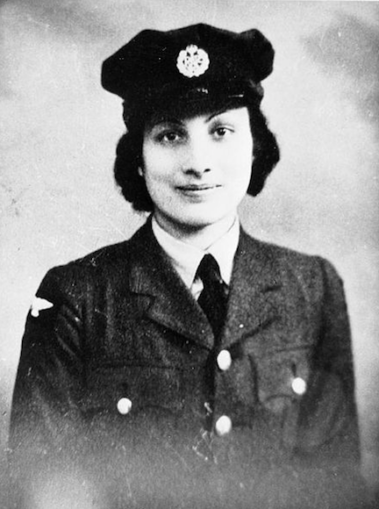
Hon. Assistant Section Officer Noor Inayat Khan,
Unknown photographer – Crown copyright expired
Nora Baker was born in Moscow on New Years’ Day 1914. Her mother was Ora Ray Baker, an American from Albuquerque, New Mexico. During her peripatetic early years, Nora was raised in London’s Bloomsberry and attended nursery in Notting Hill before completing her education at the Sorbonne and Paris Conservatoire where she studied Child Psychology and the harp respectively.
Her father died in 1927, leaving widow Ora, Nora and three younger children in Paris. At the outbreak of the Second World War, the family fled to Bordeaux and then to Southampton. In November 1940, Nora joined the Women’s Auxiliary Air Force (WAAF) and was subsequently recruited to the Special Operations Executive (SOE) as a radio operator.
In 1943, she returned to France to use her wireless skills for the Paris based Prosper resistance network. Codenamed ‘Madeleine’, her contact was to be a M. Henri Garry, codenamed Cinema or Phono. The plan being she would be his wireless woman in the Le Mans area.
Soon afterwards, many members of the network were arrested with ‘Madeline’ avoiding capture and remaining in France, on the run and constantly changing her appearance while continuing transmissions to London.
In October 1943 she was betrayed to the Sicherheitsdienst, the intelligence wing of the Waffen SS. Nazanin Zahari-Ratcliffe style, her tradecraft was sloppy and the Germans were able to use her equipment and undisposed of previous signals to trick London into sending new agents to be captured upon arrival.
Baker escaped from captivity, via the roof of the SS’s Paris HQ on Foch Avenue but was soon re-captured and sent to Germany. It was in Dachau concentration camp, near Munich, where she was shot in December 1944, aged 30. Nora was posthumously awarded the George Cross in 1949.
***
As early as 1955, a television programme had been made about her wartime experience. On June 14th the Bradford Observer noted twelve years ago that week, a courageous Indian girl had been dropped by a lone Lysander as she travelled to the French capital to be the ‘only Resistance wireless operator in Paris’. The Observer continued,
“Her work proved so dangerous that British Intelligence ordered her to leave but she begged them to allow her to remain at her post.”
The show was produced by Duncan Ross who had previously written a TV play about the Resistance called The Silent People. His work on Nora was based upon her friend Jean Overton Fuller’s biography. The lead was played by Rosalie Critchley.
Allmovie.com notes Rosalie was cast in gloomy, tragic parts and was ‘slight, dark and sharp-featured’, often playing ‘mystery women, wronged wives and sinister housekeepers’. Wiki adds, ‘She had dark piercing eyes and often played foreign or rather sinister characters’.
As part of her research, Miss Overton Fuller had placed the following appeal in the letters page of the London Daily News of 28th November 1949, using the Indianised version of Nora’s forename along with, in the Indian style, her father’s name.
Biography, I am engaged in writing the biography of the late Miss Noor Inayat Khan G C. If any readers who have known this lady would care to furnish me with any personal reminiscences such as would be suitable for inclusion I should be more than grateful.
(Miss) Jean Overton Fuller BA, 4 Guilford Place, London WC 1
The finished work, published by Gollancz in 1952 priced 13s 6d (67p) was entitled Madeline, Miss Inayat Khan’s Resistance code name. The book was well-received but not ebulliently so. Vernon Fane, in a brief review in The Sphere, called the work a moving and inspiring book of a most courageous figure.
By the 2nd revised edition, published in 1988, Nora had been promoted from Noor Inayat Khan to Noor-Un-Nisa Inayat Khan, although on the cover she still looks very white. As a mark of changing times, still un-married Jean Overton Fuller is no longer by-lined as a ‘Miss’.
A Yorkshire Post and Leeds Intelligencer review of the first (1952) edition refers to Ms Khan’s parents as being ‘an American woman and an Indian mystic of Indian origin’.
That Indian mystic was Inayat Khan Rehmat Khan great-great-grandson of Tipu Sultan, a ruler of Mysore. One of the Karnataka Khans, Inayat belonged to a long line of hereditary nobles and musicians.
As well as Russia, as a young man Mr Khan had toured the United States where he met his American wife-to-be, Ora May Baker, in New York. A poet, philosopher and musician he was also to pioneer the introduction of the Indian mystical tradition of Sufism to the West.
In 1915, the Women’s Freedom League were advertising Mr Khan’s Esoteric Lectures, every Tuesday at 5 and Sundays at 6 pm at 86 Ladbrook Road (close to Holland Park tube station). All were welcome. Admission was free. By 1917, Mr Khan was pictured in The Bournemouth Graphic with the Royal Musicians of Hindustan, famous musicians who were presenting an Eastern Musical at the Winter Gardens on Friday afternoon while attired in Durbat costume of turban and flowing robes.
In 1996 an edition of the BBC’s Hidden Empire covered his daughter’s story with the heroine now a ‘high-born Muslim woman’. Another life story of Ms Khan appeared in 2008 written by Shrabani Basu author of Curry: The Story of a Nation’s Favourite Dish and Victoria and Abdul: The True Story of the Queen’s Closest Confidant. Entitled Spy Princess, Nora had now been promoted to royalty.
The renewed interest resulted in the founding of the Noor Inayat Khan Memorial Trust with a bust of Ms Khan being unveiled in 2012. The BBC’s coverage of the ceremony, with Princess Anne presiding in the University of London’s Gordon Square Gardens, refers to the subject as being a British-Indian agent and as a,
“Sufi who believed in non-violence and religious harmony and had yet volunteered to be in the frontline.”
In the sculpture, the princess still appears as white as Princess Anne.
In 2014 Noor appeared on a stamp, the Royal Mail including her in a ‘Remarkable Lives’ set which included lesser mortals such as Dylan Thomas and Sir Alec Guinness.
Amazingly, a 2018 New York Times article declared Noor had been overlooked and suggested she appear on the back of £50 notes. Times Journalist Amie Tsang added the SOE officer had done the work of six radio operators.
Moving closer to the present day, in August 2020 an English Heritage blue plaque was fixed to 4 Taviton Street, Bloomsbury, where Noor stayed between 1942 and 1943. Her friend Miss Overton Fuller lived at Number 1. Noting gender as well as racial and religious sensitivities, English Heritage announced her the ‘first female radio operator to be sent into occupied France’.
The Daily Mail’s coverage, as well as mentioning Sufism and Indian-American heritage also throws in ‘Britain’s first Muslim war heroine in Europe’. Old pictures of Noor have now been colourised to make her browner. On wiki she now appears thus:

Noor Inayat Khan, c.1943.,
Russeltarr – Licence CC BY-SA 4.0
There is no respite. With full identity politics battle honours being saught, no attempt is made to disguise the culture war woke utility of Miss Noor’s short life. In January 2021 it was announced another TV series is to be made, this one directed by Anand Tucker and produced by Andy Paterson. In a Guardian interview, Paterson said,
“It’s fabulous, in terms of diversity, to find proper, wonderful stories that take you there without contrivance. She was an amazing character. I can’t believe her story’s never been told by film-makers.”
As Puffins will have realised by now, Paterson couldn’t be more wrong. As well as Hidden Empire and the 1952 television play there was also a 2006 documentary entitled The Princess Spy and a 2014 PBS movie, Enemy of the Reich: The Noor Inayat Khan Story. Tucker had an even nuttier comment,
“Our series challenges ideas of heroism and the portrayal of Asian women on screen – often victims, sometimes terrorists – never the hero.”
What would the real and original Nora Baker make of all of this? I’d wager the shy pacifist heroine would be embarrassed at an entire nation’s war against the Axis being reduced to a crackpot hagiography conferred upon her by a media bubble unable to cope with the modern-day cultural divisions of gender, religion and race.
© Always Worth Saying 2022



